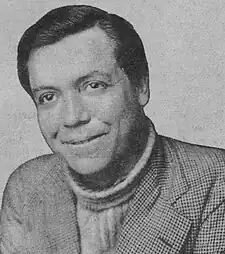Jean Fontenoy | |
|---|---|
 | |
| Personal details | |
| Born | 21 March 1899 Fontainebleau, Seine-et-Marne, France |
| Died | 28 April 1945 (aged 46) Berlin, Nazi Germany |
| Political party | National Popular Rally Revolutionary Social Movement Parti Populaire Français |
| Spouses | |
| Military service | |
| Allegiance | |
| Branch/service | German Army Finnish Army French Army |
| Years of service | 1941-1942 (Nazi Germany) 1939-1940 (Finland) 1918-1922 (France) |
| Rank | Lieutenant (Finland) Second Lieutenant (France) |
| Unit | |
| Battles/wars | |
Jean Fontenoy (21 March 1899 – 28 April 1945) was a French journalist and fascist politician who was a collaborator with Nazi Germany.
Biography
Born in Fontainebleau, Seine-et-Marne, Fontenoy worked as a journalist for the Havas news agency from 1924 to the mid-1930s in Russia then China.[1] In China, he founded the French-language Journal de Shanghai[2] and became the subject of a gossip campaign suggesting that he was having an affair with Soong Mei-ling, Chiang Kai-shek's wife.[1]
Returning to France he sought involvement in politics, initially with the French Communist Party before he switched to the French Popular Party, a group that he left in 1939 because of his personal dislike of its leader, Jacques Doriot.[1] Before long, however, Fontenoy put his personal issues to one side, rejoined the PPF and played a leading role in helping to reorganise the movement, and he also wrote widely not only for the PPF newspapers but also for the likes of L'Insurgé and Je suis partout.[1]
Despite his skill as an organiser and writer, Fontenoy began to develop a reputation for eccentricity that was aided by his personal habits. Already an alcoholic, Fontenoy was widowed in 1941 and began to abuse opium and morphine.[1] He was also seriously injured after volunteering for service in the Winter War and the head wounds that he sustained led to brain damage.[1]
After those instances, Fontenoy continued to be a leading figure on the far right, but his actions came to be somewhat more erratic. In 1938 he married Madeleine Charnaux.
For a time, he served Pierre Laval as his personal envoy to Otto Abetz.[1] That was followed by the launch of the newspaper La Vie Nationale, which proved short-lived and was followed by a number of equally-short-lived collaborationist reviews.[1]
He was a founder of Mouvement Social Révolutionnaire and became leader of the group in 1942 after Eugène Deloncle had stepped aside. However, Fonteony soon lost interest in what was a declining group.[3] He then switched over to the National Popular Rally and formed part of the five-man directorate, chaired by Marcel Déat, that led the group.[4]
During that period, Fontenoy became fixated with the notion that Doriot was plotting to kill him despite a lack of evidence.[1] That played a role in his next move in which he enrolled in the Legion of French Volunteers Against Bolshevism (LVF) and was sent to the Eastern Front. He served as LVF propaganda chief who was also acting as a spy.[5] He was killed while he was fighting the Soviets in Berlin a few days before the end of the war after he had been fatally shot in the head.[6]
Bibliography
- Gérard GUEGAN, Fontenoy ne reviendra plus, Stock, Parijs, 2011
- Philippe VILGIER, Jean Fontenoy, aventurier, journaliste et écrivain, Uitg. Via Romana, 2012
References
- 1 2 3 4 5 6 7 8 9 Philip Rees, Biographical Dictionary of the Extreme Right Since 1890, 1990, p. 130
- ↑ Issues of Le Journal de Shangaï in Gallica, the digital library of the BnF.
- ↑ David Littlejohn, The Patriotic Traitors, London: Heinemann, 1972, p. 215
- ↑ Littlejohn, The Patriotic Traitors, p. 213
- ↑ Rees, Biographical Dictionary of the Extreme Right, p. 131
- ↑ Littlejohn, The Patriotic Traitors, p. 355